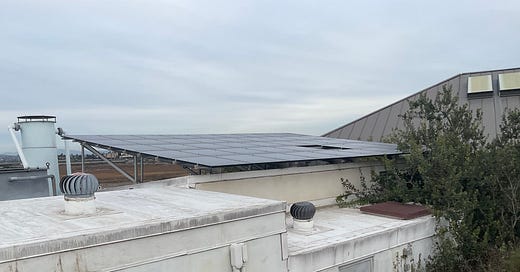Good news about rooftop solar
From California to the rest of the world communities and governments are supporting the smart way to do green energy
First of all, I hope you had a happy Thanksgiving, that no matter how you celebrated, you had joy and reasons for thankfulness.
I imagine many of us, if not most of us, are wary of a second Trump presidency and what it means for the environment. His promise to “drill, baby, drill” is a clear signal that there will be a return to the policies of his previous administration when this country not only lost progress but actually went backwards on climate change and other environmental issues. The budget-slashing team of Musk and Ramaswamy promise to take a chainsaw to federal agencies, weakening or outright eliminating the EPA, the Fish and Wildlife Service, and other parts of the federal government that ensure we have clean water, clean air, and a healthy environment.
So it’s time for some good news. And environmentally, we can be thankful for the progress we can make despite Trump and MAGA. Inspired by my Substack colleague,
, who recently wrote about the atrocious “green” energy practice of bulldozing deserts to install large solar energy operations, I wanted to look at the progress we have made and are making on rooftop solar.*Since I was in college, I’ve been a big proponent of rooftop solar. Rooftop solar simply adds to the built environment. Sitting atop homes and factories, no open spaces or natural lands are disturbed to gain good, carbon free, energy. No power lines are strung through wilderness or neighborhoods to transmit the electricity from deserts to communities. The power is right there on top of your roof. Duh!
Depending on the regulations of their municipalities, many folks who install solar panels on their homes can sell their excess power to their electric company and wind up with a few bucks in their pockets from time to time instead of paying out on their electric bill.
Good news for rooftop solar
On Earth Day of this year, the Biden administration announced the EPA was releasing grants totaling $7 billion for rooftop solar projects. Achieved through the Solar for All grant competition, which is part of the Inflation Reduction Act, the program will install solar panels on over 900,000 households throughout the United States. In making the announcement, the White House said:
The 60 selections under the $7 billion Solar for All program will provide funds to states, territories, Tribal governments, municipalities, and nonprofits across the country to develop long-lasting solar programs that enable low-income and disadvantaged communities to deploy and benefit from distributed residential solar, lowering energy costs for families, creating good-quality jobs in communities that have been left behind, advancing environmental justice and tackling climate change.
Even without federal or state subsidies, solar panels for your home can have more than just environmental benefits. Solar panels are a good investment. Here in the United States, the average cost of installing panels is around $12,700. Besides the lowered electric bills and good karma, investing that money for panels can be a smart move because homes with rooftop solar sell for 6.8 percent more than houses without, on average increasing the selling value of a house by more than $25,000.
According to The Australian, that country’s solar capacity will exceed that provided by coal by the end of 2024. The effects have been profound. Australia’s CO2 emissions from electricity generation have decreased by 30 percent since 2015.
After finding that its rooftop solar installation had dropped by 26 percent in May, India renewed its promotion of rooftop solar, financing the drive with $240.5 million provided by the Asian Development Bank. The funding will be used to install rooftop solar atop residential, commercial, and industrial buildings.
Just this past week, Switzerland is embarking on a program to install solar panels on the country’s freeway noise barriers. It is estimated that, once complete, the program will generate 100 gigawatt hours of solar power per year.
In Indonesia, that country’s Ministry of Energy and Mineral Resources has set a goal of 5,746 megawatts to be generated on the rooftops of that country by 2028. In June of this year, Scotland reduced the amount of paperwork homeowners needed to wade through to put solar power on their homes. They also got rid of restrictions on the amount of power an individual home could generate and lifted other limits.
I saved the best for last. Here in Southern California, we import water from Northern California and the Colorado River using a network of pipes, pumps, and canals. As the canals traverse hundreds of miles, some of which is though hot, arid landscapes, much of that water evaporates, as much as eleven percent, or 60 billion gallons of water every year.
Under the present administration of governor Gavin Newsom, California has embarked on a pilot project to cover our canals with solar panels. This is a win-win idea. Shading the canals will greatly reduce evaporation, saving water, money, and the environment, and the solar panels will generate 13 gigawatts of clean, carbon-free power every year.
*Rooftop solar is putting solar panels atop residences and commercial buildings, but I’m including any panels installed atop any of the built environment.
You can also find me at paul4earth.bsky.social.






May I politely remind you that the current administration is responsible for the most fossil fuel extraction in our history.....
Paul!!! I'm so glad to see you, Brother. my account got hacked and deleted. I wish I could tell you how grateful I am to stumble into you. 🙏